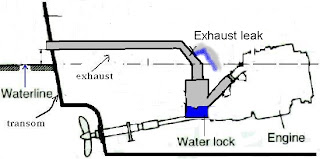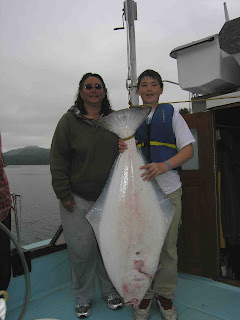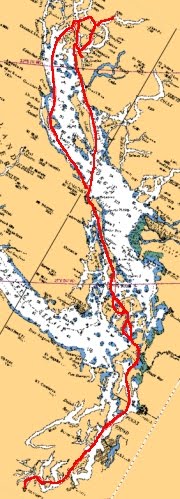Remember we're on a boat, so the rules of least mess and work apply. That means one pot. So what victuals do you need in your larder for green curry? In British Columbia you can buy powdered coconut milk which works good in a pinch, but I prefer a can of real coconut milk. Don't mess with trying to make your own green curry spices, just by a jar of pre-made green curry. Again, believe it or not, many of the little coastal marina grocery stores carry pre-made jars of green curry spices. Popular brands are Mae Ploy, Taste of Thai, Thai Taste, Maesri and many more. It will help to have fish sauce, lime juice, brown sugar, and some dried basil (If you have fresh basil - great). Finally, some canned jalapeno's (or fresh) to add some heat. How do you want to serve your green curry? You can use Ramen noodles, Minute Rice, or any kind of noodles. Hey! It's your curry.
Ready, let's start to make your boat version of green curry...
You will need the following ingredients handy:
- 1 can coconut milk. Do not shake can. You want the cream on top.
- Jar of green curry paste
- Can of chicken, or 1 lb. of fresh pork, or a dozen prawns.
- Vegetables: 1 stalk celery chopped, 1 carrot chopped, or can green beans (drained), or chopped zucchini, or whatever veggies you have available
- 1 T fish sauce
- 1 T lime juice
- 1 t brown sugar
- 1 T dried basil
- chopped jalapenos, optional (fresh or canned) to your taste
- Grab a deep pot, and heat 1 t of oil over medium high heat.
- Open your can of coconut milk and spoon the heavy cream into the pot. Do not add the whole can, just the creamy stuff on the top leaving the coconut water to be added later. Cook this for about 2-3 minutes, stirring frequently. Don't burn it.
- Add at least 1 T (or more) of the green curry paste to the thickening coconut cream and mix well continue to cook over medium high heat for about 2-3 minutes. By cooking it like this you'll really bring out the spices and flavors of the coconut and curry. By now, the aroma of exotic spices are filling the boat. Again, don't burn your paste.
- If you are using chicken or pork add this now. If you are using fresh pork, pound the meat a bit with a hammer to make it tender and cut it into 1/2"-1" chunks. If you are going to use shrimp go to the next step. Mix your chicken or pork well into the green curry and coconut cream. You may also add your vegetables at this time.
- Reduce the heat to low, and add the remaining coconut milk or water to the pot and stir. Add 1 T of lime juice and 1 T fish sauce, and 1 t of brown sugar. You want to get those tangy, sweet, and salty flavors. You may also add some chopped jalapenos to your curry depending on how hot you want it. Finally add 1 T of dried basil or 1/4 C of fresh basil. Finally, add 1 C of water to the pot. Let all this simmer, covered, for about 10-15 minutes until the meat is fully cooked through. If you are using fresh shrimp, add them in the last 5 minutes of cooking.
- Next add your package of Ramen noodles or 1 C Minute Rice to the pot, stir well, remove from heat and let the pot sit covered for about 5 minutes.
- Ladle curry into bowls and serve with extra fish sauce, or lime wedges. If you want to be extra fancy, top with more fresh basil, some shredded carrots, and a few crushed peanuts.
- Always check the regulations first. For Washington waters, you will want to visit the Department of Fish & Wildlife site: http://wdfw.wa.gov/fishing/shellfish/gear_rules.html. Make sure you have the right pot mesh size, buoy, labeling on your buoy, and know your area. For BC waters visit: http://www.pac.dfo-mpo.gc.ca/fm-gp/rec/species-especes/shrimps-crevettes-eng.htm
- For gear, make sure you have a good shrimp pot, at least 300' of sturdy nylon line - I prefer 3/8" inch (doesn't cut into your hands so bad). And a way to spool your line. Have at least one clip on lead weight. Clip the lead weight about 20' down from where you tie up your buoy so other boaters will not entangle your pot line. The proper buoy. In BC waters I use a large cherry buoy, but in Washington waters you must have a yellow buoy. Make sure your name, boat name, and address are on the buoy. I use paint versus a marker - seems to last longer.
- Avoid high current areas and popular navigation channels - if you don't you are bound to lose gear and/or not get many prawns.
- Use a GPS to mark your spot where you set your pot. Drop your pot down and make sure you watch the line go straight down, not at an angle. If you set your prawn trap and the line is going down at an angle of more than 20 degrees, you are not setting your pot where you think you are. I generally drop the trap and keep the motor in and out of gear to stay right on top of where I set it. Just don't get the line caught in the prop - bad.
- Watch the tides and currents. Again, high current areas will net you only a few prawns. Look for areas where there is minimal current. If possible set your prawn trap during a neap tide when there is minimal water exchange.
- Best prawning spots are where streams flow into a deep inlet and just below the drop off, especially on an underwater shelf. Setting your prawn tap on the side of an underwater cliff will net you few prawns; but at the base of that underwater cliff is generally productive. Use your depth sounder to get a good picture of what the bottom might look like where you are setting your pot.
- Do not use fish heads in your prawn bait. Large rockfish or ling cod are predators of prawns. Prawns will see the eyes and avoid your bait. I did a test of two prawn traps - one with heads, one with carcasses with no heads. Carcasses always had more prawns than heads. I find that fresh bait works better than old, stinky bait.
- If not illegal (like in Washington) sew a dark canvas tarp tightly around your prawn trap. Prawns like dark areas. This will make it harder to retrieve but you'll have more prawns.
 |
| Big bowl of spot prawns from Kingcome Inlet |















